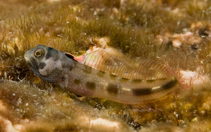| Family: |
Chaenopsidae (Pike-, tube- and flagblennies) |
| Max. size: |
5.1 cm SL (male/unsexed); 4 cm SL (female) |
| Environment: |
demersal; marine; depth range 1 - 3 m |
| Distribution: |
Eastern Pacific: Gulf of California (limited to Mulegé to Cabo San Lucas along the Baja Peninsula and between Isla San Pedro Nolasco and Isla San Ignacio de Farallon along the Mexican continental mainland, Ref. 26771). |
| Diagnosis: |
Dorsal spines (total): 23-25; Dorsal soft rays (total): 12-14; Anal spines: 2-2; Vertebrae: 42-44. This species is distinguished from its congeners in the Pacific, excluding its closest relatives, A. macrospilus and A. mangognatha, by having a single row of large brown blotches along its lateral midline and head spines that are pointed (vs. club-like or ridge-like). It differs from the 2 latter species by having a dark swath of melanophores on the dorsal fin in both males and females that highlights the bright orange coloration on that fin; presence of scattered melanophores reaching the tip of the lower jaw; and expression of orange as the primary bright head color. This species is further distinguishable from A. macrospilus by the 71 fixed mutations in COI and 20 fixed mutations in the D-loop region of its mitochondrial genome (Ref, 84469). |
| Biology: |
|
| IUCN Red List Status: |
Least Concern (LC); Date assessed: 24 March 2011 Ref. (130435)
|
| Threat to humans: |
harmless |
Source and more info: www.fishbase.org. For personal, classroom, and other internal use only. Not for publication.

